MN6008GN - Business Strategy: Strategic Formulation and Analysis
VerifiedAdded on 2023/06/15
|12
|3508
|84
Report
AI Summary
This report provides a comprehensive strategic analysis focusing on strategic formulation and its application within the financial industry, particularly in the UK. It begins by defining strategic planning and exploring its significance for financial institutions, using the hypothetical example of Amazon's 'I'm Bank'. The report investigates the challenges facing the UK financial industry, offering strategic recommendations for solutions, including leveraging the Mucaster's Managing Forces framework and break-even analysis. A critical evaluation of strategic differentiation between wholesale and retail financial activities is presented, highlighting infrastructural and operational differences. Furthermore, the report critically analyzes the effectiveness and application of the Ansoff Matrix as a strategic option model for financial organizations. The conclusion summarizes the key findings and emphasizes the importance of adaptive strategic planning for sustainable growth in the dynamic financial landscape.
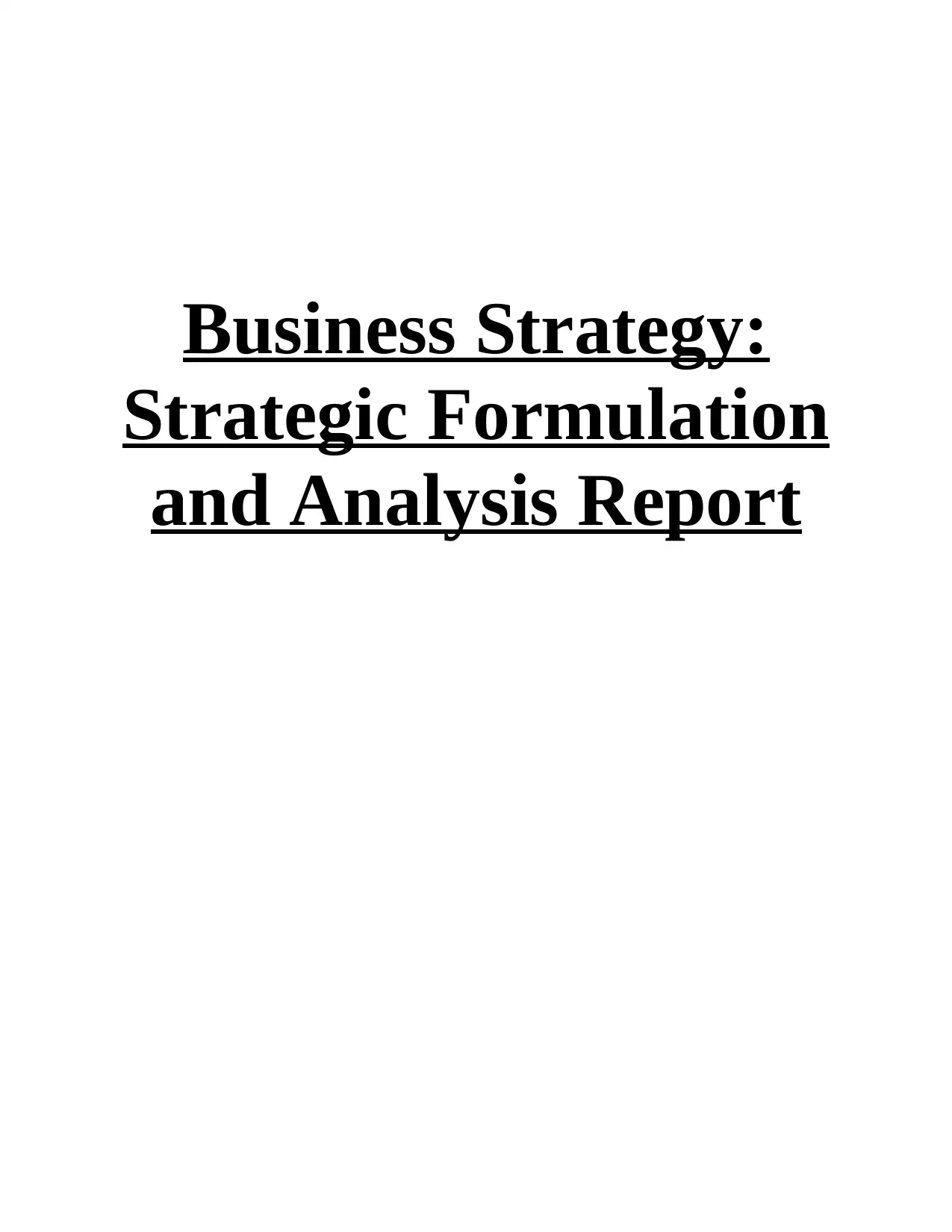
Business Strategy:
Strategic Formulation
and Analysis Report
Strategic Formulation
and Analysis Report
Paraphrase This Document
Need a fresh take? Get an instant paraphrase of this document with our AI Paraphraser
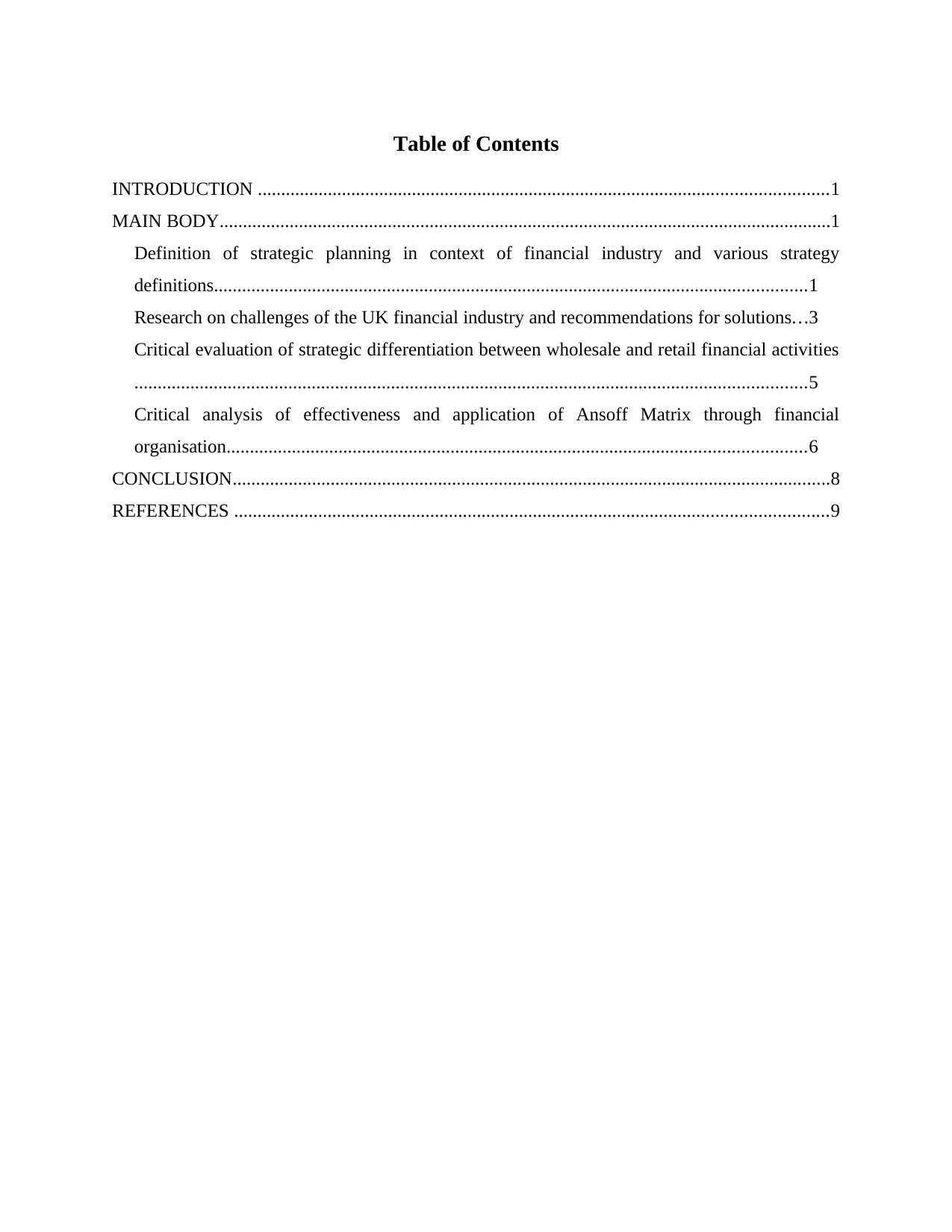
Table of Contents
INTRODUCTION ..........................................................................................................................1
MAIN BODY...................................................................................................................................1
Definition of strategic planning in context of financial industry and various strategy
definitions...............................................................................................................................1
Research on challenges of the UK financial industry and recommendations for solutions...3
Critical evaluation of strategic differentiation between wholesale and retail financial activities
................................................................................................................................................5
Critical analysis of effectiveness and application of Ansoff Matrix through financial
organisation............................................................................................................................6
CONCLUSION................................................................................................................................8
REFERENCES ...............................................................................................................................9
INTRODUCTION ..........................................................................................................................1
MAIN BODY...................................................................................................................................1
Definition of strategic planning in context of financial industry and various strategy
definitions...............................................................................................................................1
Research on challenges of the UK financial industry and recommendations for solutions...3
Critical evaluation of strategic differentiation between wholesale and retail financial activities
................................................................................................................................................5
Critical analysis of effectiveness and application of Ansoff Matrix through financial
organisation............................................................................................................................6
CONCLUSION................................................................................................................................8
REFERENCES ...............................................................................................................................9
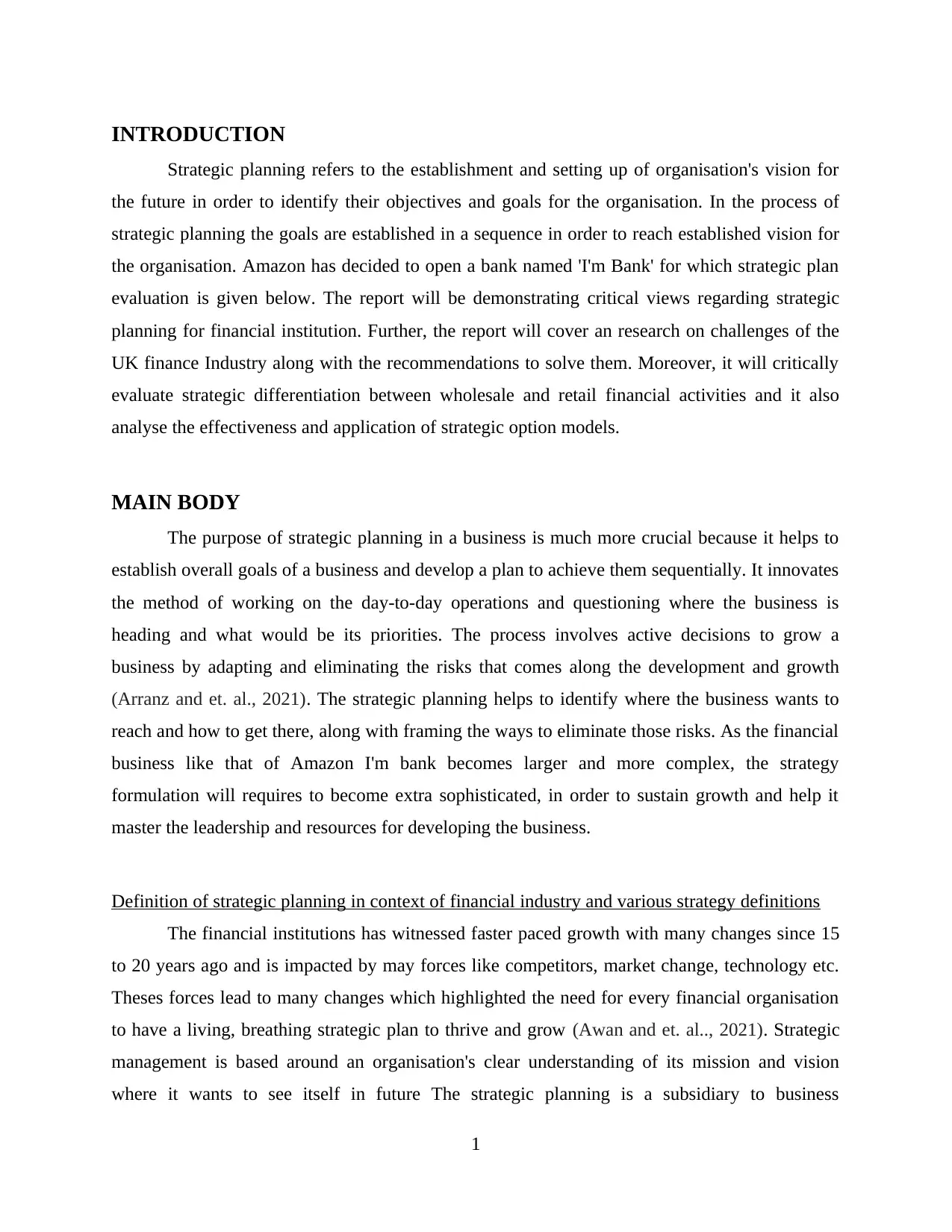
INTRODUCTION
Strategic planning refers to the establishment and setting up of organisation's vision for
the future in order to identify their objectives and goals for the organisation. In the process of
strategic planning the goals are established in a sequence in order to reach established vision for
the organisation. Amazon has decided to open a bank named 'I'm Bank' for which strategic plan
evaluation is given below. The report will be demonstrating critical views regarding strategic
planning for financial institution. Further, the report will cover an research on challenges of the
UK finance Industry along with the recommendations to solve them. Moreover, it will critically
evaluate strategic differentiation between wholesale and retail financial activities and it also
analyse the effectiveness and application of strategic option models.
MAIN BODY
The purpose of strategic planning in a business is much more crucial because it helps to
establish overall goals of a business and develop a plan to achieve them sequentially. It innovates
the method of working on the day-to-day operations and questioning where the business is
heading and what would be its priorities. The process involves active decisions to grow a
business by adapting and eliminating the risks that comes along the development and growth
(Arranz and et. al., 2021). The strategic planning helps to identify where the business wants to
reach and how to get there, along with framing the ways to eliminate those risks. As the financial
business like that of Amazon I'm bank becomes larger and more complex, the strategy
formulation will requires to become extra sophisticated, in order to sustain growth and help it
master the leadership and resources for developing the business.
Definition of strategic planning in context of financial industry and various strategy definitions
The financial institutions has witnessed faster paced growth with many changes since 15
to 20 years ago and is impacted by may forces like competitors, market change, technology etc.
Theses forces lead to many changes which highlighted the need for every financial organisation
to have a living, breathing strategic plan to thrive and grow (Awan and et. al.., 2021). Strategic
management is based around an organisation's clear understanding of its mission and vision
where it wants to see itself in future The strategic planning is a subsidiary to business
1
Strategic planning refers to the establishment and setting up of organisation's vision for
the future in order to identify their objectives and goals for the organisation. In the process of
strategic planning the goals are established in a sequence in order to reach established vision for
the organisation. Amazon has decided to open a bank named 'I'm Bank' for which strategic plan
evaluation is given below. The report will be demonstrating critical views regarding strategic
planning for financial institution. Further, the report will cover an research on challenges of the
UK finance Industry along with the recommendations to solve them. Moreover, it will critically
evaluate strategic differentiation between wholesale and retail financial activities and it also
analyse the effectiveness and application of strategic option models.
MAIN BODY
The purpose of strategic planning in a business is much more crucial because it helps to
establish overall goals of a business and develop a plan to achieve them sequentially. It innovates
the method of working on the day-to-day operations and questioning where the business is
heading and what would be its priorities. The process involves active decisions to grow a
business by adapting and eliminating the risks that comes along the development and growth
(Arranz and et. al., 2021). The strategic planning helps to identify where the business wants to
reach and how to get there, along with framing the ways to eliminate those risks. As the financial
business like that of Amazon I'm bank becomes larger and more complex, the strategy
formulation will requires to become extra sophisticated, in order to sustain growth and help it
master the leadership and resources for developing the business.
Definition of strategic planning in context of financial industry and various strategy definitions
The financial institutions has witnessed faster paced growth with many changes since 15
to 20 years ago and is impacted by may forces like competitors, market change, technology etc.
Theses forces lead to many changes which highlighted the need for every financial organisation
to have a living, breathing strategic plan to thrive and grow (Awan and et. al.., 2021). Strategic
management is based around an organisation's clear understanding of its mission and vision
where it wants to see itself in future The strategic planning is a subsidiary to business
1
⊘ This is a preview!⊘
Do you want full access?
Subscribe today to unlock all pages.

Trusted by 1+ million students worldwide
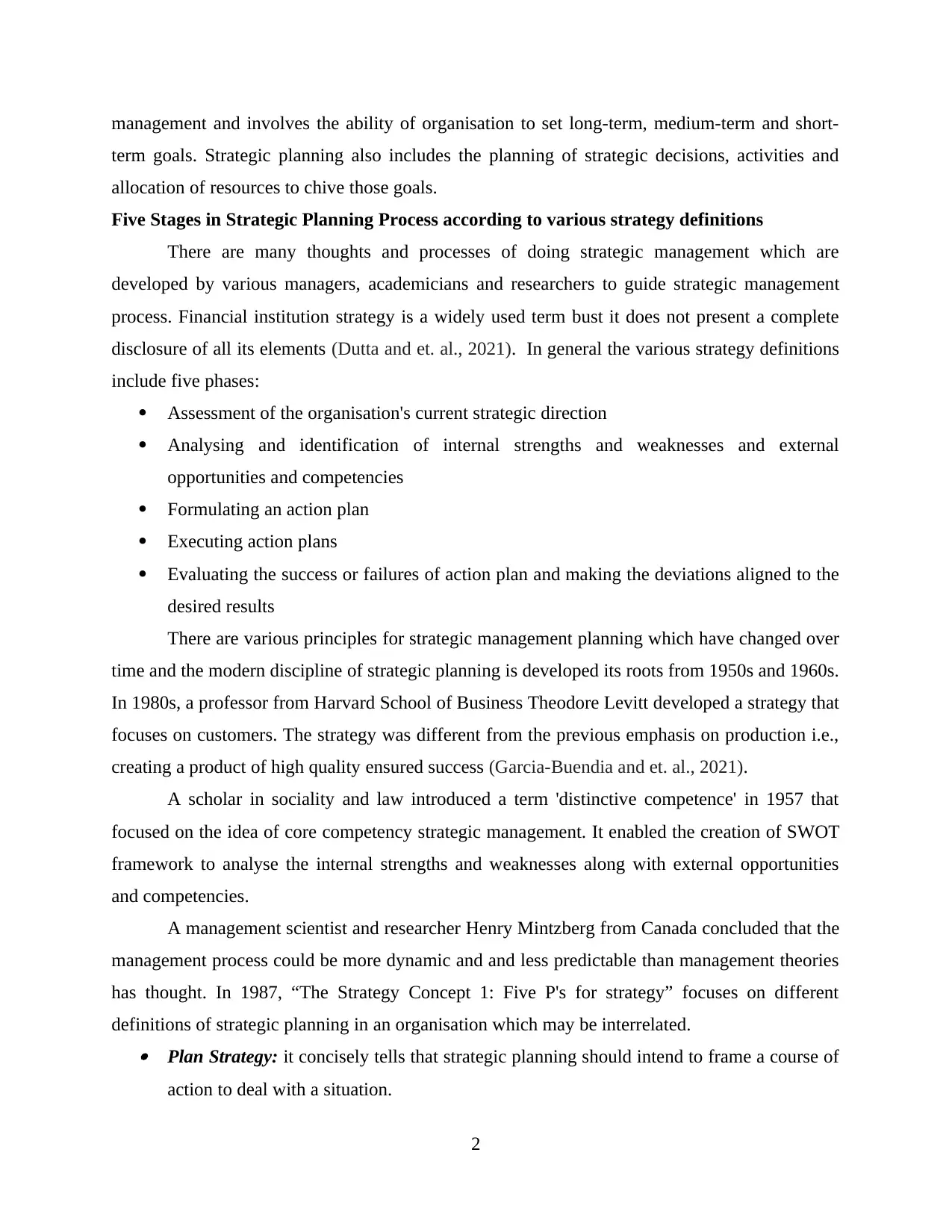
management and involves the ability of organisation to set long-term, medium-term and short-
term goals. Strategic planning also includes the planning of strategic decisions, activities and
allocation of resources to chive those goals.
Five Stages in Strategic Planning Process according to various strategy definitions
There are many thoughts and processes of doing strategic management which are
developed by various managers, academicians and researchers to guide strategic management
process. Financial institution strategy is a widely used term bust it does not present a complete
disclosure of all its elements (Dutta and et. al., 2021). In general the various strategy definitions
include five phases:
Assessment of the organisation's current strategic direction
Analysing and identification of internal strengths and weaknesses and external
opportunities and competencies
Formulating an action plan
Executing action plans
Evaluating the success or failures of action plan and making the deviations aligned to the
desired results
There are various principles for strategic management planning which have changed over
time and the modern discipline of strategic planning is developed its roots from 1950s and 1960s.
In 1980s, a professor from Harvard School of Business Theodore Levitt developed a strategy that
focuses on customers. The strategy was different from the previous emphasis on production i.e.,
creating a product of high quality ensured success (Garcia-Buendia and et. al., 2021).
A scholar in sociality and law introduced a term 'distinctive competence' in 1957 that
focused on the idea of core competency strategic management. It enabled the creation of SWOT
framework to analyse the internal strengths and weaknesses along with external opportunities
and competencies.
A management scientist and researcher Henry Mintzberg from Canada concluded that the
management process could be more dynamic and and less predictable than management theories
has thought. In 1987, “The Strategy Concept 1: Five P's for strategy” focuses on different
definitions of strategic planning in an organisation which may be interrelated. Plan Strategy: it concisely tells that strategic planning should intend to frame a course of
action to deal with a situation.
2
term goals. Strategic planning also includes the planning of strategic decisions, activities and
allocation of resources to chive those goals.
Five Stages in Strategic Planning Process according to various strategy definitions
There are many thoughts and processes of doing strategic management which are
developed by various managers, academicians and researchers to guide strategic management
process. Financial institution strategy is a widely used term bust it does not present a complete
disclosure of all its elements (Dutta and et. al., 2021). In general the various strategy definitions
include five phases:
Assessment of the organisation's current strategic direction
Analysing and identification of internal strengths and weaknesses and external
opportunities and competencies
Formulating an action plan
Executing action plans
Evaluating the success or failures of action plan and making the deviations aligned to the
desired results
There are various principles for strategic management planning which have changed over
time and the modern discipline of strategic planning is developed its roots from 1950s and 1960s.
In 1980s, a professor from Harvard School of Business Theodore Levitt developed a strategy that
focuses on customers. The strategy was different from the previous emphasis on production i.e.,
creating a product of high quality ensured success (Garcia-Buendia and et. al., 2021).
A scholar in sociality and law introduced a term 'distinctive competence' in 1957 that
focused on the idea of core competency strategic management. It enabled the creation of SWOT
framework to analyse the internal strengths and weaknesses along with external opportunities
and competencies.
A management scientist and researcher Henry Mintzberg from Canada concluded that the
management process could be more dynamic and and less predictable than management theories
has thought. In 1987, “The Strategy Concept 1: Five P's for strategy” focuses on different
definitions of strategic planning in an organisation which may be interrelated. Plan Strategy: it concisely tells that strategic planning should intend to frame a course of
action to deal with a situation.
2
Paraphrase This Document
Need a fresh take? Get an instant paraphrase of this document with our AI Paraphraser
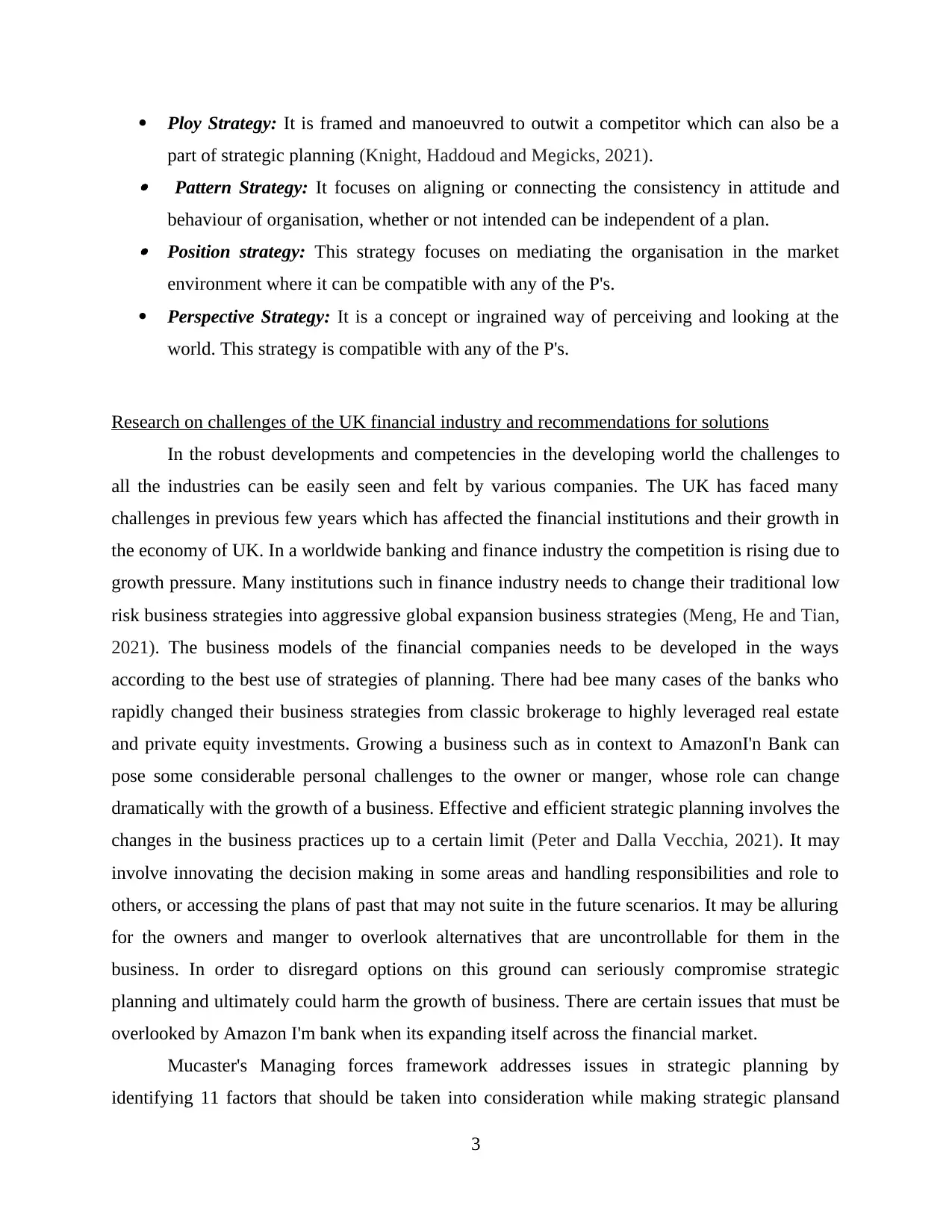
Ploy Strategy: It is framed and manoeuvred to outwit a competitor which can also be a
part of strategic planning (Knight, Haddoud and Megicks, 2021). Pattern Strategy: It focuses on aligning or connecting the consistency in attitude and
behaviour of organisation, whether or not intended can be independent of a plan. Position strategy: This strategy focuses on mediating the organisation in the market
environment where it can be compatible with any of the P's.
Perspective Strategy: It is a concept or ingrained way of perceiving and looking at the
world. This strategy is compatible with any of the P's.
Research on challenges of the UK financial industry and recommendations for solutions
In the robust developments and competencies in the developing world the challenges to
all the industries can be easily seen and felt by various companies. The UK has faced many
challenges in previous few years which has affected the financial institutions and their growth in
the economy of UK. In a worldwide banking and finance industry the competition is rising due to
growth pressure. Many institutions such in finance industry needs to change their traditional low
risk business strategies into aggressive global expansion business strategies (Meng, He and Tian,
2021). The business models of the financial companies needs to be developed in the ways
according to the best use of strategies of planning. There had bee many cases of the banks who
rapidly changed their business strategies from classic brokerage to highly leveraged real estate
and private equity investments. Growing a business such as in context to AmazonI'n Bank can
pose some considerable personal challenges to the owner or manger, whose role can change
dramatically with the growth of a business. Effective and efficient strategic planning involves the
changes in the business practices up to a certain limit (Peter and Dalla Vecchia, 2021). It may
involve innovating the decision making in some areas and handling responsibilities and role to
others, or accessing the plans of past that may not suite in the future scenarios. It may be alluring
for the owners and manger to overlook alternatives that are uncontrollable for them in the
business. In order to disregard options on this ground can seriously compromise strategic
planning and ultimately could harm the growth of business. There are certain issues that must be
overlooked by Amazon I'm bank when its expanding itself across the financial market.
Mucaster's Managing forces framework addresses issues in strategic planning by
identifying 11 factors that should be taken into consideration while making strategic plansand
3
part of strategic planning (Knight, Haddoud and Megicks, 2021). Pattern Strategy: It focuses on aligning or connecting the consistency in attitude and
behaviour of organisation, whether or not intended can be independent of a plan. Position strategy: This strategy focuses on mediating the organisation in the market
environment where it can be compatible with any of the P's.
Perspective Strategy: It is a concept or ingrained way of perceiving and looking at the
world. This strategy is compatible with any of the P's.
Research on challenges of the UK financial industry and recommendations for solutions
In the robust developments and competencies in the developing world the challenges to
all the industries can be easily seen and felt by various companies. The UK has faced many
challenges in previous few years which has affected the financial institutions and their growth in
the economy of UK. In a worldwide banking and finance industry the competition is rising due to
growth pressure. Many institutions such in finance industry needs to change their traditional low
risk business strategies into aggressive global expansion business strategies (Meng, He and Tian,
2021). The business models of the financial companies needs to be developed in the ways
according to the best use of strategies of planning. There had bee many cases of the banks who
rapidly changed their business strategies from classic brokerage to highly leveraged real estate
and private equity investments. Growing a business such as in context to AmazonI'n Bank can
pose some considerable personal challenges to the owner or manger, whose role can change
dramatically with the growth of a business. Effective and efficient strategic planning involves the
changes in the business practices up to a certain limit (Peter and Dalla Vecchia, 2021). It may
involve innovating the decision making in some areas and handling responsibilities and role to
others, or accessing the plans of past that may not suite in the future scenarios. It may be alluring
for the owners and manger to overlook alternatives that are uncontrollable for them in the
business. In order to disregard options on this ground can seriously compromise strategic
planning and ultimately could harm the growth of business. There are certain issues that must be
overlooked by Amazon I'm bank when its expanding itself across the financial market.
Mucaster's Managing forces framework addresses issues in strategic planning by
identifying 11 factors that should be taken into consideration while making strategic plansand
3
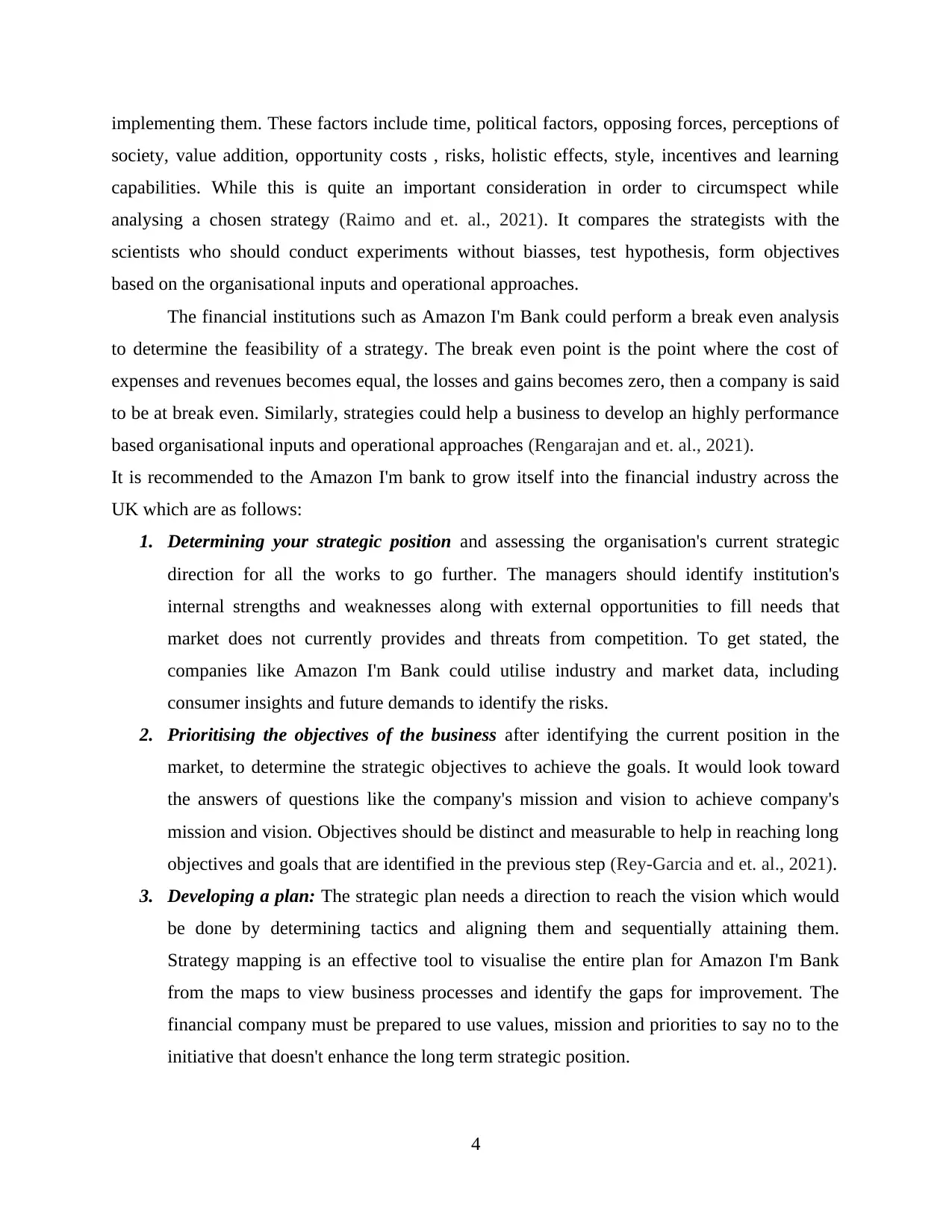
implementing them. These factors include time, political factors, opposing forces, perceptions of
society, value addition, opportunity costs , risks, holistic effects, style, incentives and learning
capabilities. While this is quite an important consideration in order to circumspect while
analysing a chosen strategy (Raimo and et. al., 2021). It compares the strategists with the
scientists who should conduct experiments without biasses, test hypothesis, form objectives
based on the organisational inputs and operational approaches.
The financial institutions such as Amazon I'm Bank could perform a break even analysis
to determine the feasibility of a strategy. The break even point is the point where the cost of
expenses and revenues becomes equal, the losses and gains becomes zero, then a company is said
to be at break even. Similarly, strategies could help a business to develop an highly performance
based organisational inputs and operational approaches (Rengarajan and et. al., 2021).
It is recommended to the Amazon I'm bank to grow itself into the financial industry across the
UK which are as follows:
1. Determining your strategic position and assessing the organisation's current strategic
direction for all the works to go further. The managers should identify institution's
internal strengths and weaknesses along with external opportunities to fill needs that
market does not currently provides and threats from competition. To get stated, the
companies like Amazon I'm Bank could utilise industry and market data, including
consumer insights and future demands to identify the risks.
2. Prioritising the objectives of the business after identifying the current position in the
market, to determine the strategic objectives to achieve the goals. It would look toward
the answers of questions like the company's mission and vision to achieve company's
mission and vision. Objectives should be distinct and measurable to help in reaching long
objectives and goals that are identified in the previous step (Rey-Garcia and et. al., 2021).
3. Developing a plan: The strategic plan needs a direction to reach the vision which would
be done by determining tactics and aligning them and sequentially attaining them.
Strategy mapping is an effective tool to visualise the entire plan for Amazon I'm Bank
from the maps to view business processes and identify the gaps for improvement. The
financial company must be prepared to use values, mission and priorities to say no to the
initiative that doesn't enhance the long term strategic position.
4
society, value addition, opportunity costs , risks, holistic effects, style, incentives and learning
capabilities. While this is quite an important consideration in order to circumspect while
analysing a chosen strategy (Raimo and et. al., 2021). It compares the strategists with the
scientists who should conduct experiments without biasses, test hypothesis, form objectives
based on the organisational inputs and operational approaches.
The financial institutions such as Amazon I'm Bank could perform a break even analysis
to determine the feasibility of a strategy. The break even point is the point where the cost of
expenses and revenues becomes equal, the losses and gains becomes zero, then a company is said
to be at break even. Similarly, strategies could help a business to develop an highly performance
based organisational inputs and operational approaches (Rengarajan and et. al., 2021).
It is recommended to the Amazon I'm bank to grow itself into the financial industry across the
UK which are as follows:
1. Determining your strategic position and assessing the organisation's current strategic
direction for all the works to go further. The managers should identify institution's
internal strengths and weaknesses along with external opportunities to fill needs that
market does not currently provides and threats from competition. To get stated, the
companies like Amazon I'm Bank could utilise industry and market data, including
consumer insights and future demands to identify the risks.
2. Prioritising the objectives of the business after identifying the current position in the
market, to determine the strategic objectives to achieve the goals. It would look toward
the answers of questions like the company's mission and vision to achieve company's
mission and vision. Objectives should be distinct and measurable to help in reaching long
objectives and goals that are identified in the previous step (Rey-Garcia and et. al., 2021).
3. Developing a plan: The strategic plan needs a direction to reach the vision which would
be done by determining tactics and aligning them and sequentially attaining them.
Strategy mapping is an effective tool to visualise the entire plan for Amazon I'm Bank
from the maps to view business processes and identify the gaps for improvement. The
financial company must be prepared to use values, mission and priorities to say no to the
initiative that doesn't enhance the long term strategic position.
4
⊘ This is a preview!⊘
Do you want full access?
Subscribe today to unlock all pages.

Trusted by 1+ million students worldwide
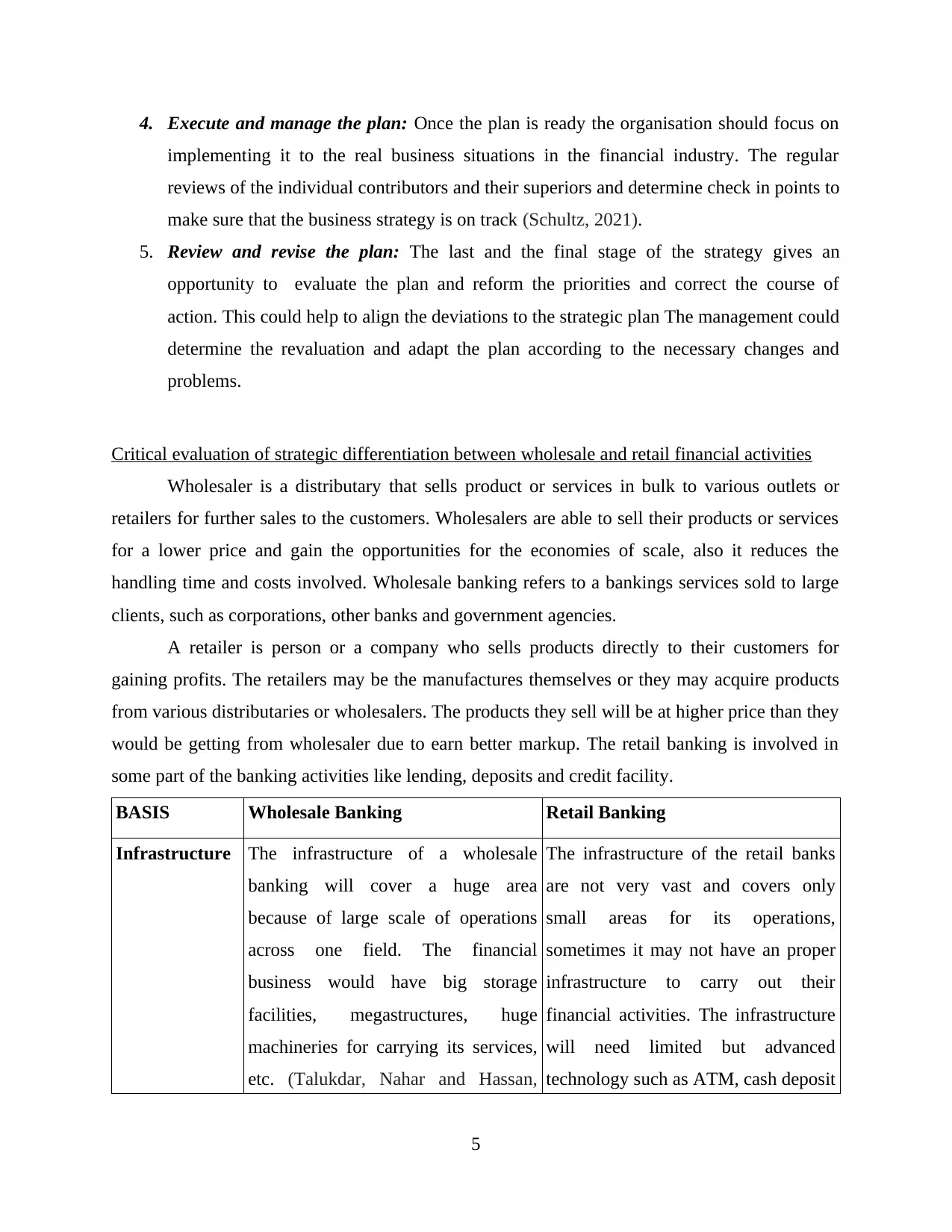
4. Execute and manage the plan: Once the plan is ready the organisation should focus on
implementing it to the real business situations in the financial industry. The regular
reviews of the individual contributors and their superiors and determine check in points to
make sure that the business strategy is on track (Schultz, 2021).
5. Review and revise the plan: The last and the final stage of the strategy gives an
opportunity to evaluate the plan and reform the priorities and correct the course of
action. This could help to align the deviations to the strategic plan The management could
determine the revaluation and adapt the plan according to the necessary changes and
problems.
Critical evaluation of strategic differentiation between wholesale and retail financial activities
Wholesaler is a distributary that sells product or services in bulk to various outlets or
retailers for further sales to the customers. Wholesalers are able to sell their products or services
for a lower price and gain the opportunities for the economies of scale, also it reduces the
handling time and costs involved. Wholesale banking refers to a bankings services sold to large
clients, such as corporations, other banks and government agencies.
A retailer is person or a company who sells products directly to their customers for
gaining profits. The retailers may be the manufactures themselves or they may acquire products
from various distributaries or wholesalers. The products they sell will be at higher price than they
would be getting from wholesaler due to earn better markup. The retail banking is involved in
some part of the banking activities like lending, deposits and credit facility.
BASIS Wholesale Banking Retail Banking
Infrastructure The infrastructure of a wholesale
banking will cover a huge area
because of large scale of operations
across one field. The financial
business would have big storage
facilities, megastructures, huge
machineries for carrying its services,
etc. (Talukdar, Nahar and Hassan,
The infrastructure of the retail banks
are not very vast and covers only
small areas for its operations,
sometimes it may not have an proper
infrastructure to carry out their
financial activities. The infrastructure
will need limited but advanced
technology such as ATM, cash deposit
5
implementing it to the real business situations in the financial industry. The regular
reviews of the individual contributors and their superiors and determine check in points to
make sure that the business strategy is on track (Schultz, 2021).
5. Review and revise the plan: The last and the final stage of the strategy gives an
opportunity to evaluate the plan and reform the priorities and correct the course of
action. This could help to align the deviations to the strategic plan The management could
determine the revaluation and adapt the plan according to the necessary changes and
problems.
Critical evaluation of strategic differentiation between wholesale and retail financial activities
Wholesaler is a distributary that sells product or services in bulk to various outlets or
retailers for further sales to the customers. Wholesalers are able to sell their products or services
for a lower price and gain the opportunities for the economies of scale, also it reduces the
handling time and costs involved. Wholesale banking refers to a bankings services sold to large
clients, such as corporations, other banks and government agencies.
A retailer is person or a company who sells products directly to their customers for
gaining profits. The retailers may be the manufactures themselves or they may acquire products
from various distributaries or wholesalers. The products they sell will be at higher price than they
would be getting from wholesaler due to earn better markup. The retail banking is involved in
some part of the banking activities like lending, deposits and credit facility.
BASIS Wholesale Banking Retail Banking
Infrastructure The infrastructure of a wholesale
banking will cover a huge area
because of large scale of operations
across one field. The financial
business would have big storage
facilities, megastructures, huge
machineries for carrying its services,
etc. (Talukdar, Nahar and Hassan,
The infrastructure of the retail banks
are not very vast and covers only
small areas for its operations,
sometimes it may not have an proper
infrastructure to carry out their
financial activities. The infrastructure
will need limited but advanced
technology such as ATM, cash deposit
5
Paraphrase This Document
Need a fresh take? Get an instant paraphrase of this document with our AI Paraphraser
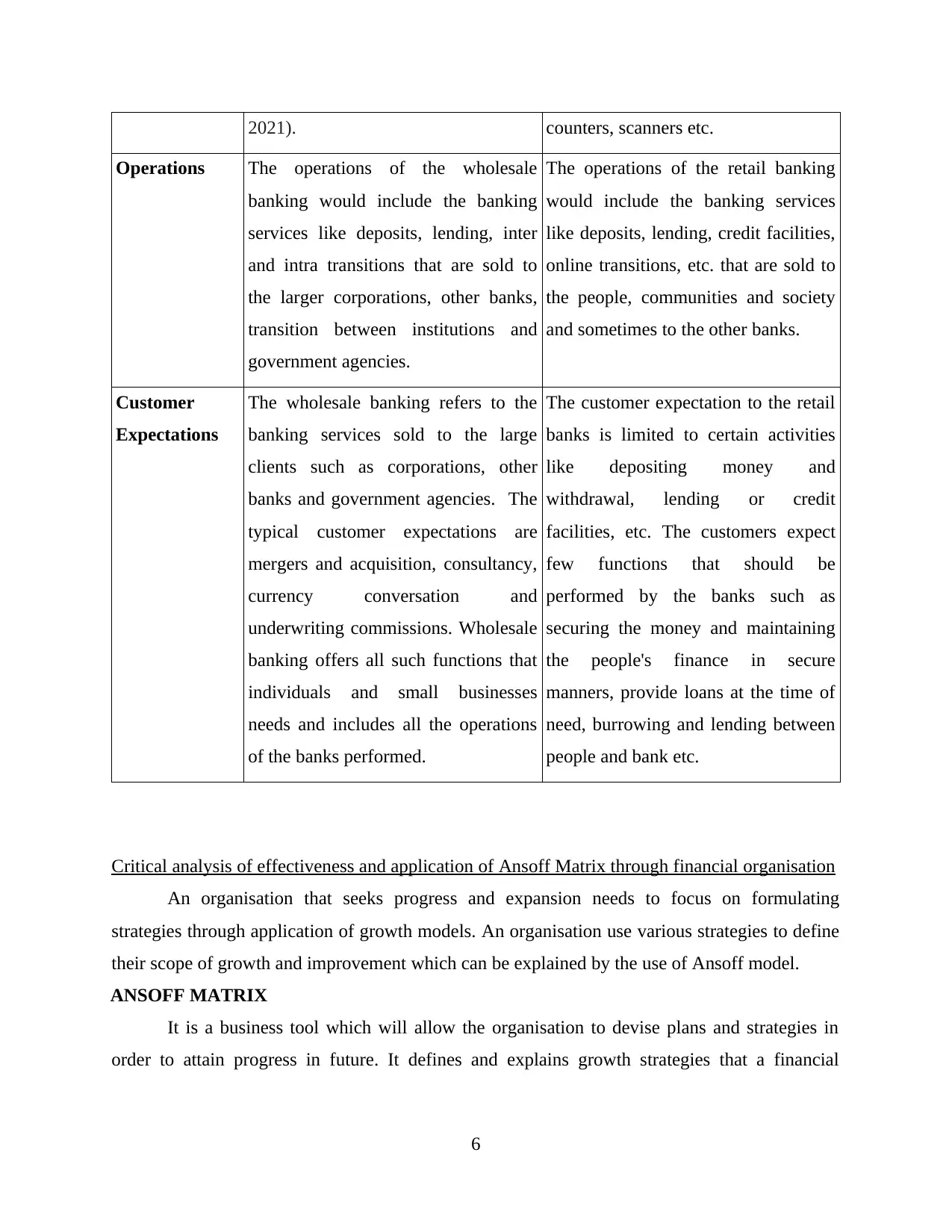
2021). counters, scanners etc.
Operations The operations of the wholesale
banking would include the banking
services like deposits, lending, inter
and intra transitions that are sold to
the larger corporations, other banks,
transition between institutions and
government agencies.
The operations of the retail banking
would include the banking services
like deposits, lending, credit facilities,
online transitions, etc. that are sold to
the people, communities and society
and sometimes to the other banks.
Customer
Expectations
The wholesale banking refers to the
banking services sold to the large
clients such as corporations, other
banks and government agencies. The
typical customer expectations are
mergers and acquisition, consultancy,
currency conversation and
underwriting commissions. Wholesale
banking offers all such functions that
individuals and small businesses
needs and includes all the operations
of the banks performed.
The customer expectation to the retail
banks is limited to certain activities
like depositing money and
withdrawal, lending or credit
facilities, etc. The customers expect
few functions that should be
performed by the banks such as
securing the money and maintaining
the people's finance in secure
manners, provide loans at the time of
need, burrowing and lending between
people and bank etc.
Critical analysis of effectiveness and application of Ansoff Matrix through financial organisation
An organisation that seeks progress and expansion needs to focus on formulating
strategies through application of growth models. An organisation use various strategies to define
their scope of growth and improvement which can be explained by the use of Ansoff model.
ANSOFF MATRIX
It is a business tool which will allow the organisation to devise plans and strategies in
order to attain progress in future. It defines and explains growth strategies that a financial
6
Operations The operations of the wholesale
banking would include the banking
services like deposits, lending, inter
and intra transitions that are sold to
the larger corporations, other banks,
transition between institutions and
government agencies.
The operations of the retail banking
would include the banking services
like deposits, lending, credit facilities,
online transitions, etc. that are sold to
the people, communities and society
and sometimes to the other banks.
Customer
Expectations
The wholesale banking refers to the
banking services sold to the large
clients such as corporations, other
banks and government agencies. The
typical customer expectations are
mergers and acquisition, consultancy,
currency conversation and
underwriting commissions. Wholesale
banking offers all such functions that
individuals and small businesses
needs and includes all the operations
of the banks performed.
The customer expectation to the retail
banks is limited to certain activities
like depositing money and
withdrawal, lending or credit
facilities, etc. The customers expect
few functions that should be
performed by the banks such as
securing the money and maintaining
the people's finance in secure
manners, provide loans at the time of
need, burrowing and lending between
people and bank etc.
Critical analysis of effectiveness and application of Ansoff Matrix through financial organisation
An organisation that seeks progress and expansion needs to focus on formulating
strategies through application of growth models. An organisation use various strategies to define
their scope of growth and improvement which can be explained by the use of Ansoff model.
ANSOFF MATRIX
It is a business tool which will allow the organisation to devise plans and strategies in
order to attain progress in future. It defines and explains growth strategies that a financial
6
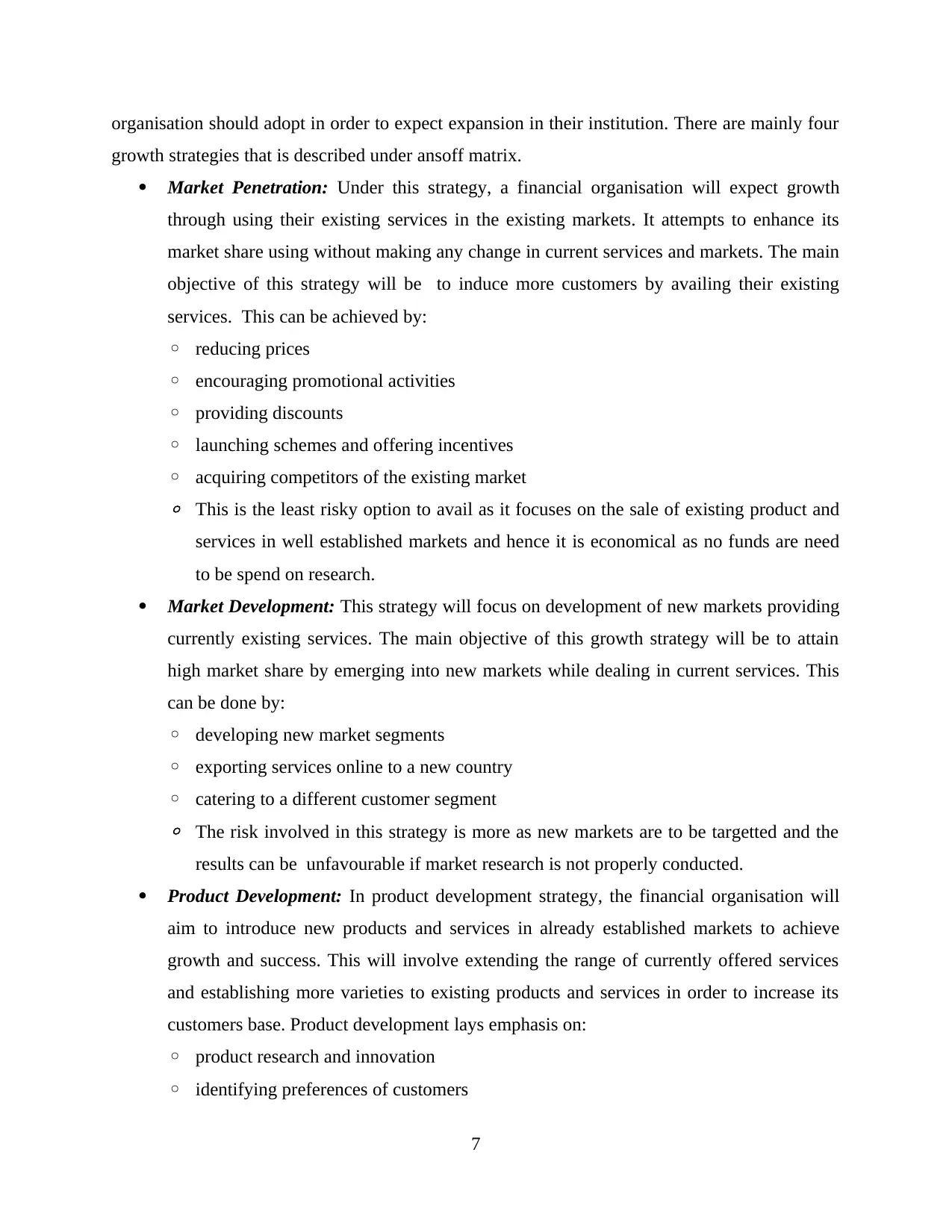
organisation should adopt in order to expect expansion in their institution. There are mainly four
growth strategies that is described under ansoff matrix.
Market Penetration: Under this strategy, a financial organisation will expect growth
through using their existing services in the existing markets. It attempts to enhance its
market share using without making any change in current services and markets. The main
objective of this strategy will be to induce more customers by availing their existing
services. This can be achieved by:
◦ reducing prices
◦ encouraging promotional activities
◦ providing discounts
◦ launching schemes and offering incentives
◦ acquiring competitors of the existing market
◦ This is the least risky option to avail as it focuses on the sale of existing product and
services in well established markets and hence it is economical as no funds are need
to be spend on research.
Market Development: This strategy will focus on development of new markets providing
currently existing services. The main objective of this growth strategy will be to attain
high market share by emerging into new markets while dealing in current services. This
can be done by:
◦ developing new market segments
◦ exporting services online to a new country
◦ catering to a different customer segment
◦ The risk involved in this strategy is more as new markets are to be targetted and the
results can be unfavourable if market research is not properly conducted.
Product Development: In product development strategy, the financial organisation will
aim to introduce new products and services in already established markets to achieve
growth and success. This will involve extending the range of currently offered services
and establishing more varieties to existing products and services in order to increase its
customers base. Product development lays emphasis on:
◦ product research and innovation
◦ identifying preferences of customers
7
growth strategies that is described under ansoff matrix.
Market Penetration: Under this strategy, a financial organisation will expect growth
through using their existing services in the existing markets. It attempts to enhance its
market share using without making any change in current services and markets. The main
objective of this strategy will be to induce more customers by availing their existing
services. This can be achieved by:
◦ reducing prices
◦ encouraging promotional activities
◦ providing discounts
◦ launching schemes and offering incentives
◦ acquiring competitors of the existing market
◦ This is the least risky option to avail as it focuses on the sale of existing product and
services in well established markets and hence it is economical as no funds are need
to be spend on research.
Market Development: This strategy will focus on development of new markets providing
currently existing services. The main objective of this growth strategy will be to attain
high market share by emerging into new markets while dealing in current services. This
can be done by:
◦ developing new market segments
◦ exporting services online to a new country
◦ catering to a different customer segment
◦ The risk involved in this strategy is more as new markets are to be targetted and the
results can be unfavourable if market research is not properly conducted.
Product Development: In product development strategy, the financial organisation will
aim to introduce new products and services in already established markets to achieve
growth and success. This will involve extending the range of currently offered services
and establishing more varieties to existing products and services in order to increase its
customers base. Product development lays emphasis on:
◦ product research and innovation
◦ identifying preferences of customers
7
⊘ This is a preview!⊘
Do you want full access?
Subscribe today to unlock all pages.

Trusted by 1+ million students worldwide
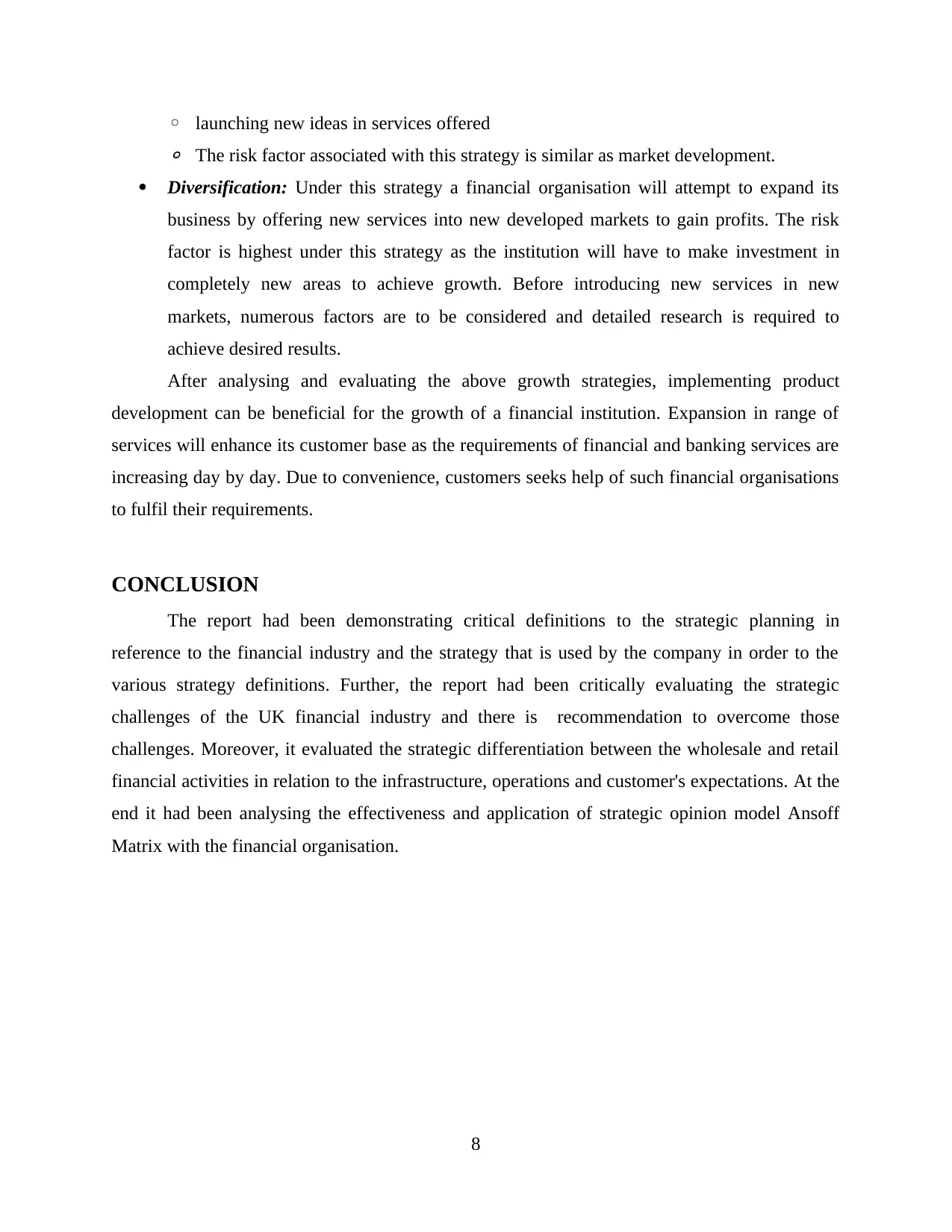
◦ launching new ideas in services offered
◦ The risk factor associated with this strategy is similar as market development.
Diversification: Under this strategy a financial organisation will attempt to expand its
business by offering new services into new developed markets to gain profits. The risk
factor is highest under this strategy as the institution will have to make investment in
completely new areas to achieve growth. Before introducing new services in new
markets, numerous factors are to be considered and detailed research is required to
achieve desired results.
After analysing and evaluating the above growth strategies, implementing product
development can be beneficial for the growth of a financial institution. Expansion in range of
services will enhance its customer base as the requirements of financial and banking services are
increasing day by day. Due to convenience, customers seeks help of such financial organisations
to fulfil their requirements.
CONCLUSION
The report had been demonstrating critical definitions to the strategic planning in
reference to the financial industry and the strategy that is used by the company in order to the
various strategy definitions. Further, the report had been critically evaluating the strategic
challenges of the UK financial industry and there is recommendation to overcome those
challenges. Moreover, it evaluated the strategic differentiation between the wholesale and retail
financial activities in relation to the infrastructure, operations and customer's expectations. At the
end it had been analysing the effectiveness and application of strategic opinion model Ansoff
Matrix with the financial organisation.
8
◦ The risk factor associated with this strategy is similar as market development.
Diversification: Under this strategy a financial organisation will attempt to expand its
business by offering new services into new developed markets to gain profits. The risk
factor is highest under this strategy as the institution will have to make investment in
completely new areas to achieve growth. Before introducing new services in new
markets, numerous factors are to be considered and detailed research is required to
achieve desired results.
After analysing and evaluating the above growth strategies, implementing product
development can be beneficial for the growth of a financial institution. Expansion in range of
services will enhance its customer base as the requirements of financial and banking services are
increasing day by day. Due to convenience, customers seeks help of such financial organisations
to fulfil their requirements.
CONCLUSION
The report had been demonstrating critical definitions to the strategic planning in
reference to the financial industry and the strategy that is used by the company in order to the
various strategy definitions. Further, the report had been critically evaluating the strategic
challenges of the UK financial industry and there is recommendation to overcome those
challenges. Moreover, it evaluated the strategic differentiation between the wholesale and retail
financial activities in relation to the infrastructure, operations and customer's expectations. At the
end it had been analysing the effectiveness and application of strategic opinion model Ansoff
Matrix with the financial organisation.
8
Paraphrase This Document
Need a fresh take? Get an instant paraphrase of this document with our AI Paraphraser
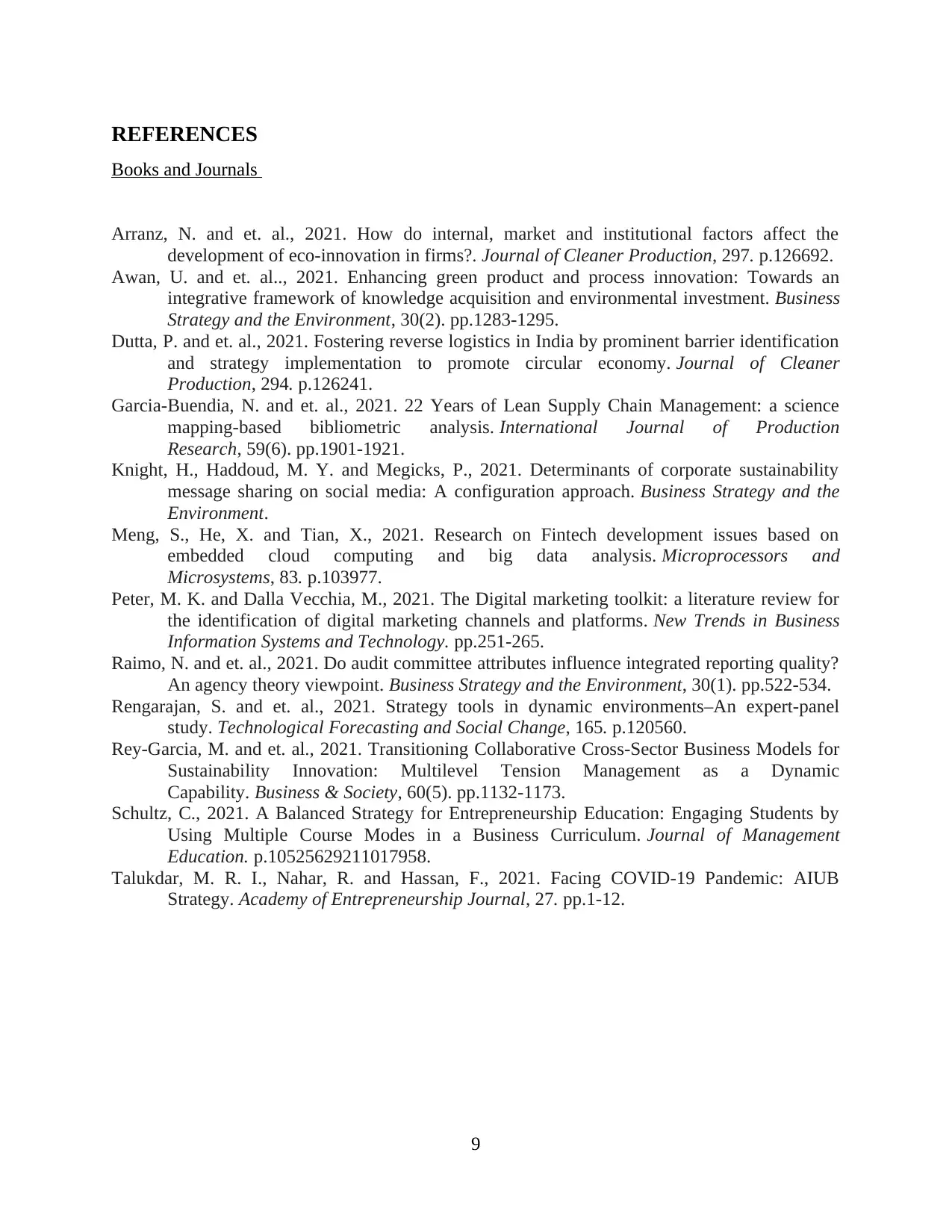
REFERENCES
Books and Journals
Arranz, N. and et. al., 2021. How do internal, market and institutional factors affect the
development of eco-innovation in firms?. Journal of Cleaner Production, 297. p.126692.
Awan, U. and et. al.., 2021. Enhancing green product and process innovation: Towards an
integrative framework of knowledge acquisition and environmental investment. Business
Strategy and the Environment, 30(2). pp.1283-1295.
Dutta, P. and et. al., 2021. Fostering reverse logistics in India by prominent barrier identification
and strategy implementation to promote circular economy. Journal of Cleaner
Production, 294. p.126241.
Garcia-Buendia, N. and et. al., 2021. 22 Years of Lean Supply Chain Management: a science
mapping-based bibliometric analysis. International Journal of Production
Research, 59(6). pp.1901-1921.
Knight, H., Haddoud, M. Y. and Megicks, P., 2021. Determinants of corporate sustainability
message sharing on social media: A configuration approach. Business Strategy and the
Environment.
Meng, S., He, X. and Tian, X., 2021. Research on Fintech development issues based on
embedded cloud computing and big data analysis. Microprocessors and
Microsystems, 83. p.103977.
Peter, M. K. and Dalla Vecchia, M., 2021. The Digital marketing toolkit: a literature review for
the identification of digital marketing channels and platforms. New Trends in Business
Information Systems and Technology. pp.251-265.
Raimo, N. and et. al., 2021. Do audit committee attributes influence integrated reporting quality?
An agency theory viewpoint. Business Strategy and the Environment, 30(1). pp.522-534.
Rengarajan, S. and et. al., 2021. Strategy tools in dynamic environments–An expert-panel
study. Technological Forecasting and Social Change, 165. p.120560.
Rey-Garcia, M. and et. al., 2021. Transitioning Collaborative Cross-Sector Business Models for
Sustainability Innovation: Multilevel Tension Management as a Dynamic
Capability. Business & Society, 60(5). pp.1132-1173.
Schultz, C., 2021. A Balanced Strategy for Entrepreneurship Education: Engaging Students by
Using Multiple Course Modes in a Business Curriculum. Journal of Management
Education. p.10525629211017958.
Talukdar, M. R. I., Nahar, R. and Hassan, F., 2021. Facing COVID-19 Pandemic: AIUB
Strategy. Academy of Entrepreneurship Journal, 27. pp.1-12.
9
Books and Journals
Arranz, N. and et. al., 2021. How do internal, market and institutional factors affect the
development of eco-innovation in firms?. Journal of Cleaner Production, 297. p.126692.
Awan, U. and et. al.., 2021. Enhancing green product and process innovation: Towards an
integrative framework of knowledge acquisition and environmental investment. Business
Strategy and the Environment, 30(2). pp.1283-1295.
Dutta, P. and et. al., 2021. Fostering reverse logistics in India by prominent barrier identification
and strategy implementation to promote circular economy. Journal of Cleaner
Production, 294. p.126241.
Garcia-Buendia, N. and et. al., 2021. 22 Years of Lean Supply Chain Management: a science
mapping-based bibliometric analysis. International Journal of Production
Research, 59(6). pp.1901-1921.
Knight, H., Haddoud, M. Y. and Megicks, P., 2021. Determinants of corporate sustainability
message sharing on social media: A configuration approach. Business Strategy and the
Environment.
Meng, S., He, X. and Tian, X., 2021. Research on Fintech development issues based on
embedded cloud computing and big data analysis. Microprocessors and
Microsystems, 83. p.103977.
Peter, M. K. and Dalla Vecchia, M., 2021. The Digital marketing toolkit: a literature review for
the identification of digital marketing channels and platforms. New Trends in Business
Information Systems and Technology. pp.251-265.
Raimo, N. and et. al., 2021. Do audit committee attributes influence integrated reporting quality?
An agency theory viewpoint. Business Strategy and the Environment, 30(1). pp.522-534.
Rengarajan, S. and et. al., 2021. Strategy tools in dynamic environments–An expert-panel
study. Technological Forecasting and Social Change, 165. p.120560.
Rey-Garcia, M. and et. al., 2021. Transitioning Collaborative Cross-Sector Business Models for
Sustainability Innovation: Multilevel Tension Management as a Dynamic
Capability. Business & Society, 60(5). pp.1132-1173.
Schultz, C., 2021. A Balanced Strategy for Entrepreneurship Education: Engaging Students by
Using Multiple Course Modes in a Business Curriculum. Journal of Management
Education. p.10525629211017958.
Talukdar, M. R. I., Nahar, R. and Hassan, F., 2021. Facing COVID-19 Pandemic: AIUB
Strategy. Academy of Entrepreneurship Journal, 27. pp.1-12.
9

10
⊘ This is a preview!⊘
Do you want full access?
Subscribe today to unlock all pages.

Trusted by 1+ million students worldwide
1 out of 12
Related Documents
Your All-in-One AI-Powered Toolkit for Academic Success.
+13062052269
info@desklib.com
Available 24*7 on WhatsApp / Email
![[object Object]](/_next/static/media/star-bottom.7253800d.svg)
Unlock your academic potential
Copyright © 2020–2025 A2Z Services. All Rights Reserved. Developed and managed by ZUCOL.




